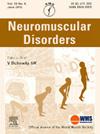03O Identification of Class I HLA genetic predispositions and prediction of autoantigenic epitopes in dermatomyositis patients of Indian origin
IF 2.7
4区 医学
Q2 CLINICAL NEUROLOGY
引用次数: 0
Abstract
The discovery of dermatomyositis (DM)-specific autoantibodies has led to a more refined categorization of DM patients into homogenous subgroups. While previous studies have demonstrated the association of Human Leucocyte Antigen (HLA) alleles with DM-specific autoantibodies, the specific epitopes involved in these associations remain unexplored. We aimed to genotype Class-I MHC alleles and to examine specific HLA genetic variants associated with DM patients and to finally predict autoantigenic epitopes. HLA-A, HLA-B, and HLA-C alleles were directly genotyped in Indian cohort of 71 DM patients and 114 ethnically matched controls by next generation sequencing, sequence-specific primer PCR assay, or multiplex assay using the blood genomic DNA. Allele frequency analysis and amino acid alignments were performed using the Genentech/MiDAS bioinformatics package. T-cell epitope prediction was performed using Immune Epitope Database and Tools (IEDB). HLA-A*33:03 allele (Pa= 0.010, OR= 12.024 [3.652 – 54.452]) was more frequently detected in DM-specific autoantibody positive patients (12.26%) than healthy controls (1.32%). Out of all the DM-specific autoantibodies, this Class-I HLA allele showed significant positive association with Mi-2 autoantibody (Pa= 0.006, OR= 15.136 [4.150 – 72.444]) only, which retained its significance after the stepwise conditioning analysis as well. Its association with rest of the autoantibody positive (anti-MDA5 (n=9), anti-NXP2 (n=8), and anti-TIF1g (n=5)) subgroups did not reach statistical significance. Based on Class-I MHC binding, processing, and immunogenicity prediction scores, 15 out of 7,614 peptides of 8 to 11 amino acid residues were predicted to be epitope of Mi-2 autoantigen. High-resolution HLA sequencing more precisely characterised the allele associated with Mi2 autoantibody. Prediction of Mi-2 autoantigenic epitopes presents promising candidates for experimental validation which could pave the way for peptide immunotherapy in Mi2-positive DM subgroup in future.
03O 印度裔皮肌炎患者 I 类 HLA 遗传倾向的鉴定和自身抗原表位的预测
皮肌炎(DM)特异性自身抗体的发现促使人们对皮肌炎患者进行更精细的分类,将其分为同质亚组。虽然先前的研究已经证明了人类白细胞抗原(HLA)等位基因与DM特异性自身抗体的关联,但这些关联所涉及的特定表位仍未得到探讨。我们的目的是对 I 类 MHC 等位基因进行基因分型,研究与 DM 患者相关的特定 HLA 基因变异,并最终预测自身抗原表位。通过新一代测序、序列特异性引物 PCR 检测或使用血液基因组 DNA 的多重检测,对印度队列中的 71 名糖尿病患者和 114 名种族匹配的对照者的 HLA-A、HLA-B 和 HLA-C 等位基因进行了直接基因分型。使用 Genentech/MiDAS 生物信息学软件包进行等位基因频率分析和氨基酸比对。T细胞表位预测使用免疫表位数据库和工具(IEDB)进行。HLA-A*33:03等位基因(Pa= 0.010,OR= 12.024 [3.652 - 54.452])在DM特异性自身抗体阳性患者(12.26%)中的检出率高于健康对照组(1.32%)。在所有 DM 特异性自身抗体中,该 I 类 HLA 等位基因仅与 Mi-2 自身抗体呈显著正相关(Pa= 0.006,OR= 15.136 [4.150 - 72.444]),在逐步条件分析后仍保持显著性。它与其他自身抗体阳性亚组(抗 MDA5(9 人)、抗 NXP2(8 人)和抗 TIF1g(5 人))的相关性未达到统计学意义。根据 I 类 MHC 结合、加工和免疫原性预测得分,在 7,614 个 8 至 11 个氨基酸残基的肽中,有 15 个被预测为 Mi-2 自身抗原的表位。高分辨率 HLA 测序更精确地确定了与 Mi2 自身抗体相关的等位基因的特征。对Mi-2自身抗原表位的预测为实验验证提供了有希望的候选对象,为将来对Mi2阳性DM亚群进行多肽免疫治疗铺平了道路。
本文章由计算机程序翻译,如有差异,请以英文原文为准。
求助全文
约1分钟内获得全文
求助全文
来源期刊

Neuromuscular Disorders
医学-临床神经学
CiteScore
4.60
自引率
3.60%
发文量
543
审稿时长
53 days
期刊介绍:
This international, multidisciplinary journal covers all aspects of neuromuscular disorders in childhood and adult life (including the muscular dystrophies, spinal muscular atrophies, hereditary neuropathies, congenital myopathies, myasthenias, myotonic syndromes, metabolic myopathies and inflammatory myopathies).
The Editors welcome original articles from all areas of the field:
• Clinical aspects, such as new clinical entities, case studies of interest, treatment, management and rehabilitation (including biomechanics, orthotic design and surgery).
• Basic scientific studies of relevance to the clinical syndromes, including advances in the fields of molecular biology and genetics.
• Studies of animal models relevant to the human diseases.
The journal is aimed at a wide range of clinicians, pathologists, associated paramedical professionals and clinical and basic scientists with an interest in the study of neuromuscular disorders.
 求助内容:
求助内容: 应助结果提醒方式:
应助结果提醒方式:


